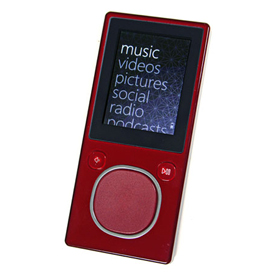 The sexy and good looking device features a beautiful LCD screen, quality sound production and a touch sensitive navigation pad. Together with the Zune 80GB hard-drive model and the ultraportable Zune 4GB, the next generation flash-based and portable media player Zune 8 was unveiled by Bill Gates and J Allard recently. Microsoft does put a very high expectation on this new generation product. In the launching interview, Gates said: “Twenty years ago we bet the company on an integrated productivity suite of word processing, spreadsheets and presentations, and we changed the way people work. Today we’re making big bets on games, music, video and connecting these entertainment experiences to help change the way people play.” What is the secret hide behind the new digital music product? Can this new Zune 8 stand a chance against the popular Apple iPod nano?
The sexy and good looking device features a beautiful LCD screen, quality sound production and a touch sensitive navigation pad. Together with the Zune 80GB hard-drive model and the ultraportable Zune 4GB, the next generation flash-based and portable media player Zune 8 was unveiled by Bill Gates and J Allard recently. Microsoft does put a very high expectation on this new generation product. In the launching interview, Gates said: “Twenty years ago we bet the company on an integrated productivity suite of word processing, spreadsheets and presentations, and we changed the way people work. Today we’re making big bets on games, music, video and connecting these entertainment experiences to help change the way people play.” What is the secret hide behind the new digital music product? Can this new Zune 8 stand a chance against the popular Apple iPod nano?
Zune 8 is pretty light, about 1.7 ounces (47 g). However, comparatively, the size is still a little thicker than one of the last-generation iPod Nanos. It has a bright 1.8” LCD screen displaying 320 by 240 pixel resolution which is just large enough to display photos, album art, and contextual menus but a bit small for videos. Zune 8 supports numerous music and video files such as MP3, WMA, M3U, M4A, M4B, WMA lossless, PlaysForSure DRM-ed audio and Zune Playlist (ZPL). The Zune can also display photos in JPG format but not PNG or GIF formats. The audio quality is superb and excellent. It has 20 digital volume control steps to adjust the sound volume. The Zune 8 comes with a touch sensitive navigation pad which allows you to scroll up and down, left or right to locate your music collections. The pad is pretty sensitive and you need a little practice to really get used to it. Zune 8 users can also use it to listen to their favorite radio station via the built-in FM radio tuner.
To increase Zune 8’s popularity, Microsoft has also launched its beta Zune Social online community. Microsoft has removed several restrictions and allowed Zune users to share their music tastes, knowledge and experiences with others.
Microsoft has spent a lot of time rethinking the social aspects of the Zune player, removing several restrictions on how you can share tracks between Zune players and adding an online community called the Zune Social. At the time of this review, the Zune Social wasn’t available for testing. Anyone can create a free, customizable Zune Card that automatically updates to reflect the music they are listening to on their Zune or with Zune software on their computer. The Zune Card shows most recently played tracks and highlights that person’s all-time music favorites. Other members of Zune Social can play samples of the songs a user has been playing directly from a friend’s Zune Card or link to Zune Marketplace, where they can buy or download the music. Music is becoming increasingly social, thus, Zune Social will eventually enable its members to place the Zune Card on today’s most popular social networking sites, where it will continue to update automatically and show off the owners’ listening tastes.
In addition to creating a friends list, members of Zune Social can send song links and messages to each other, post comments on a friend’s profile page or on their favorite artist pages. Music has become interactive like everything else! They can discover new music by seeing what their friends are listening to, receiving recommendations from others in the community or by seeing what the top fans of artists they’re interested in are listening to. Each artist page will list the Zune Cards of the people who listen to that artist the most, making it easy for other Zune Social members to browse their recent playlists and discover new content they can sample, purchase or download with a Zune Pass.
The Zune 8 will lighten your pocket by $199.99.